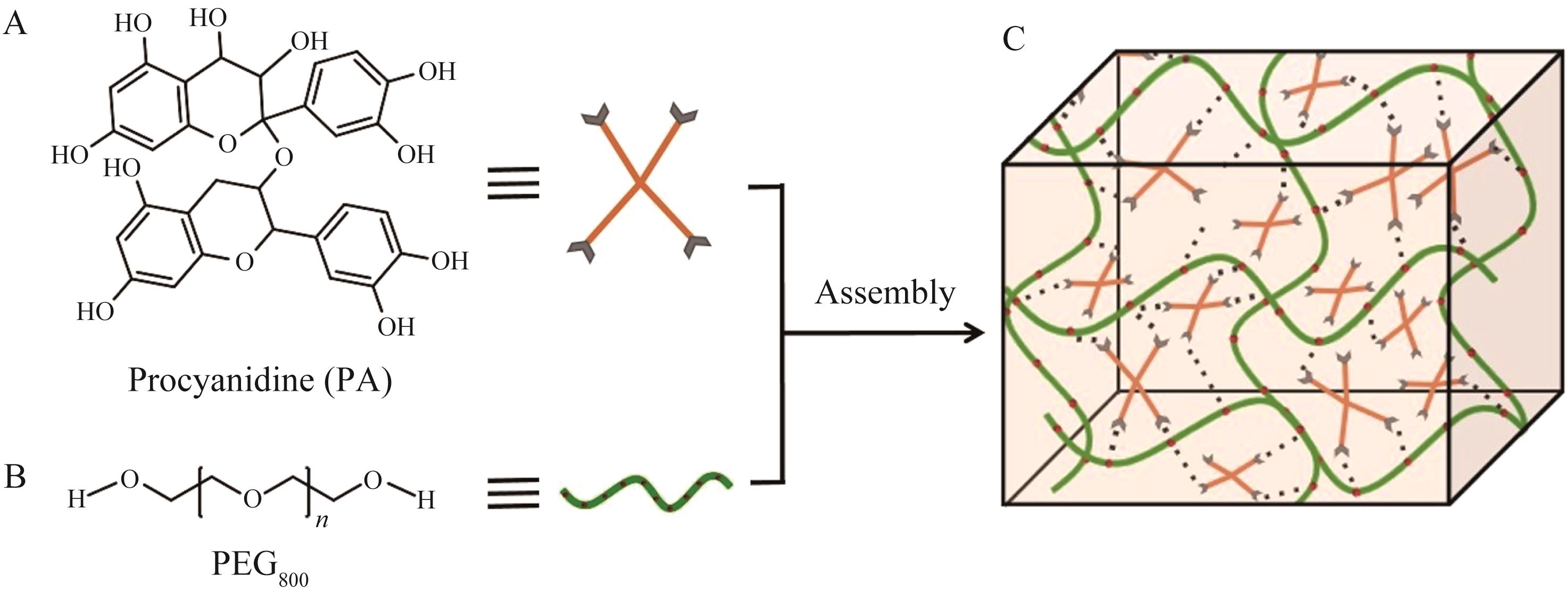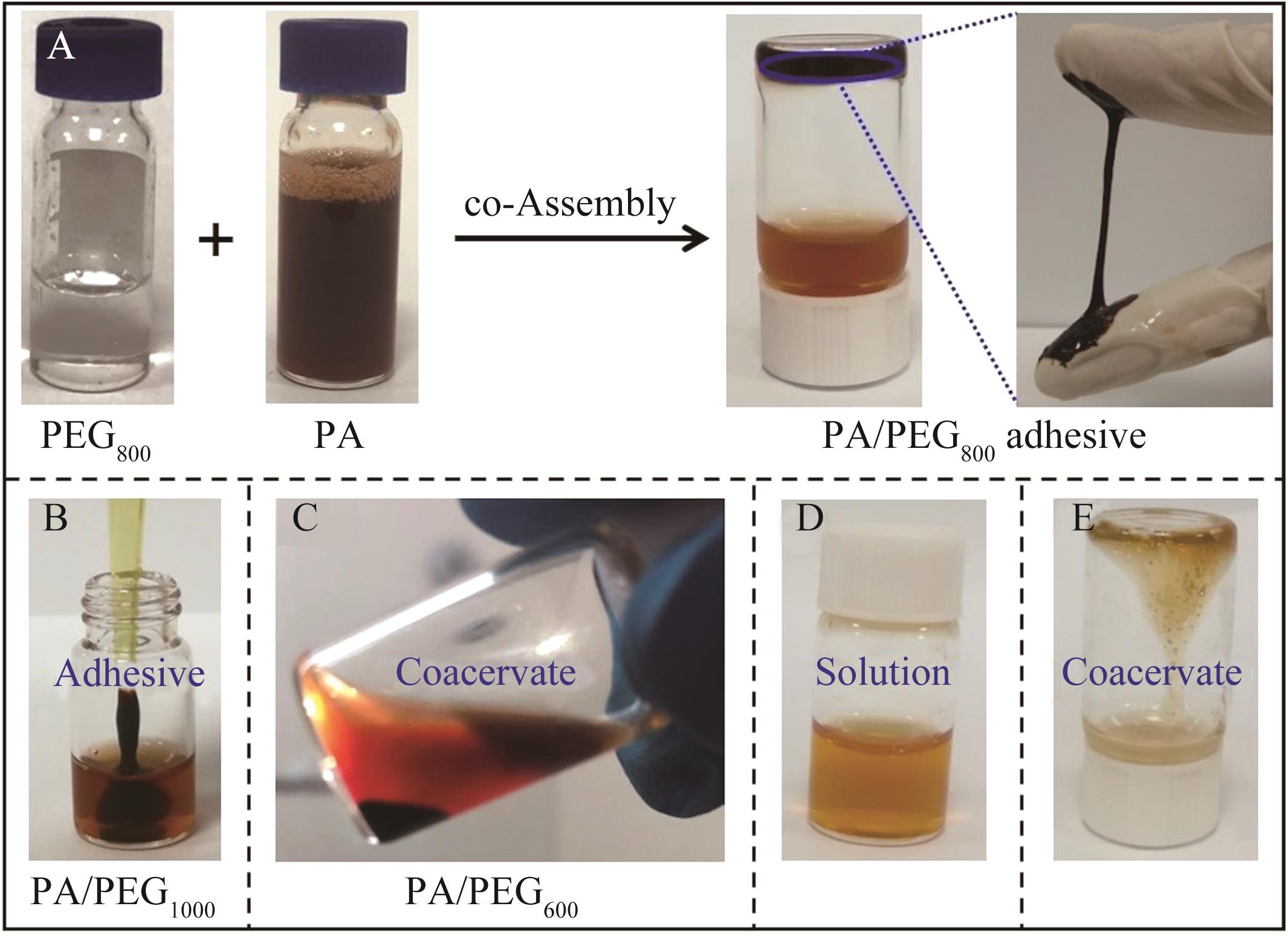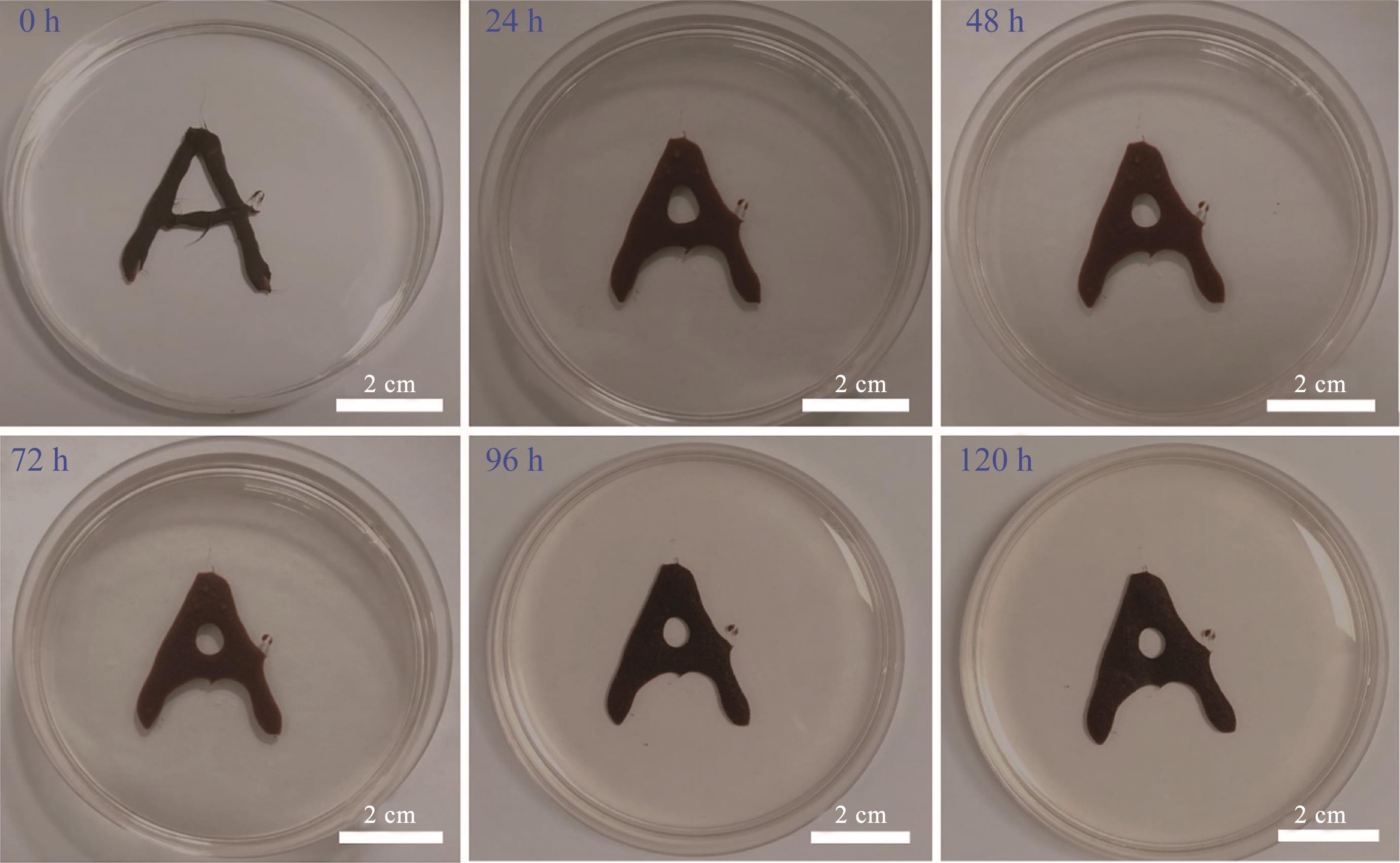
Chinese Journal of Applied Chemistry ›› 2022, Vol. 39 ›› Issue (10): 1533-1542.DOI: 10.19894/j.issn.1000-0518.220017
• Full Papers • Previous Articles Next Articles
Hydrogen Bond Interaction Driven Procyanidine Assembly into Underwater Adhesive with Antibacterial Activity
Xiao-Ming XIE1( ), Jia-Qi ZHANG2(
), Jia-Qi ZHANG2( )
)
- 1.Department of Chemistry,Xinzhou Teachers University,Xinzhou 034000,China
2.College of Physics and Optoelectronics,Taiyuan University of Technology,Taiyuan 030024,China
-
Received:2022-01-18Accepted:2022-04-18Published:2022-10-01Online:2022-10-05 -
Contact:Xiao-Ming XIE,Jia-Qi ZHANG -
About author:zjq18734238044@163.com
xiexm0910@163.com;
-
Supported by:the Natural Science Foundation of Shanxi Province(20210302124339);the Science and Technology Innovation Project of Colleges and Universities in Shanxi Province(2021L452);the Research Fund of Xinzhou Teachers University(2020KY03)
CLC Number:
Cite this article
Xiao-Ming XIE, Jia-Qi ZHANG. Hydrogen Bond Interaction Driven Procyanidine Assembly into Underwater Adhesive with Antibacterial Activity[J]. Chinese Journal of Applied Chemistry, 2022, 39(10): 1533-1542.
share this article
Add to citation manager EndNote|Ris|BibTeX
URL: http://yyhx.ciac.jl.cn/EN/10.19894/j.issn.1000-0518.220017
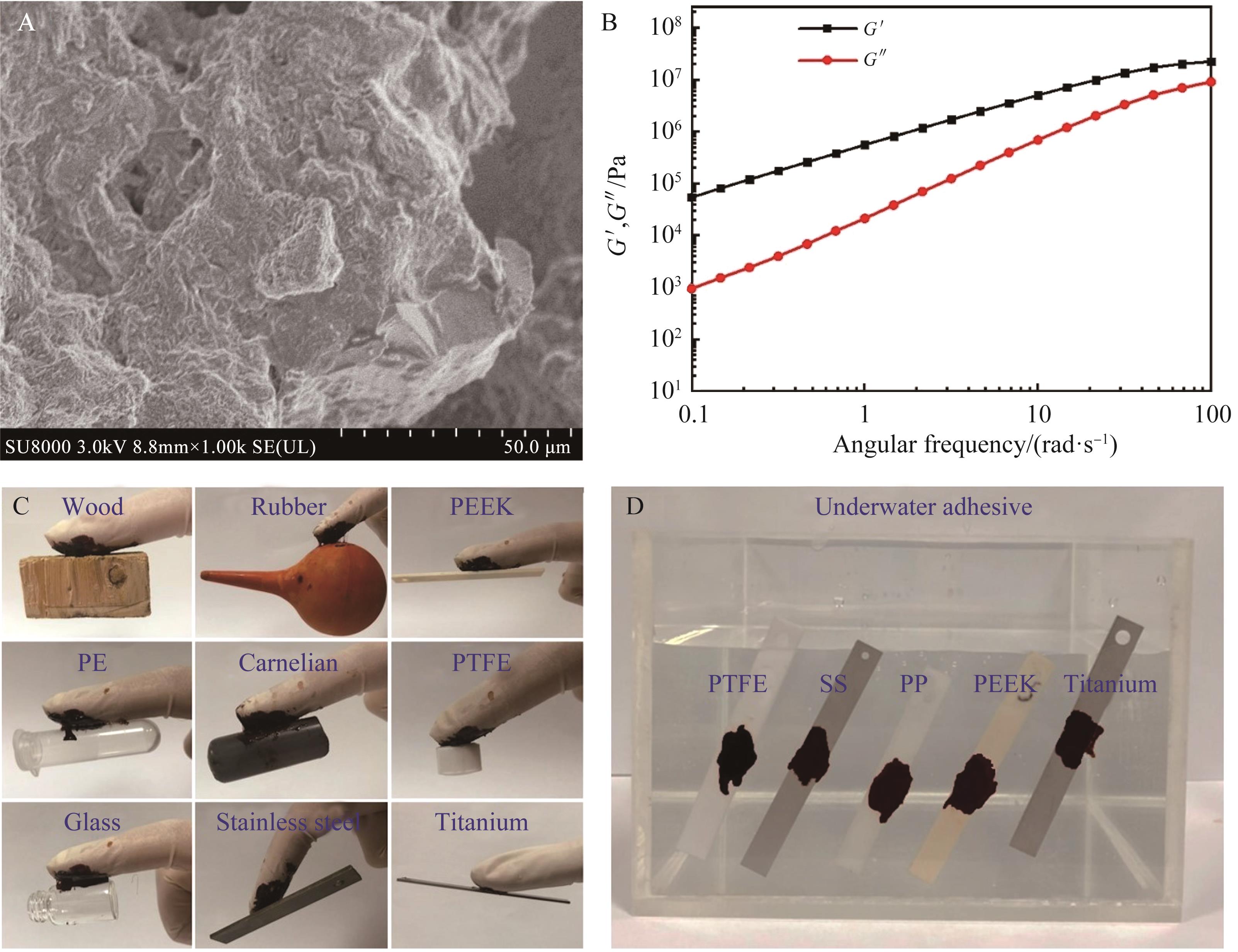
Fig.3 (A) SEM image of the PA/PEG800 adhesive; (B) Rheological behavior of the PA/PEG800 adhesive; (C) Digital images of PA/PEG800 adhesive on air adhesion for different materials including wood, rubber, PEEK, PE, caenelian, PTFE, glass, SS, Titanium; (D) Underwater adhesion for different materials including PTFE, SS, PP, PEEK and Titanium
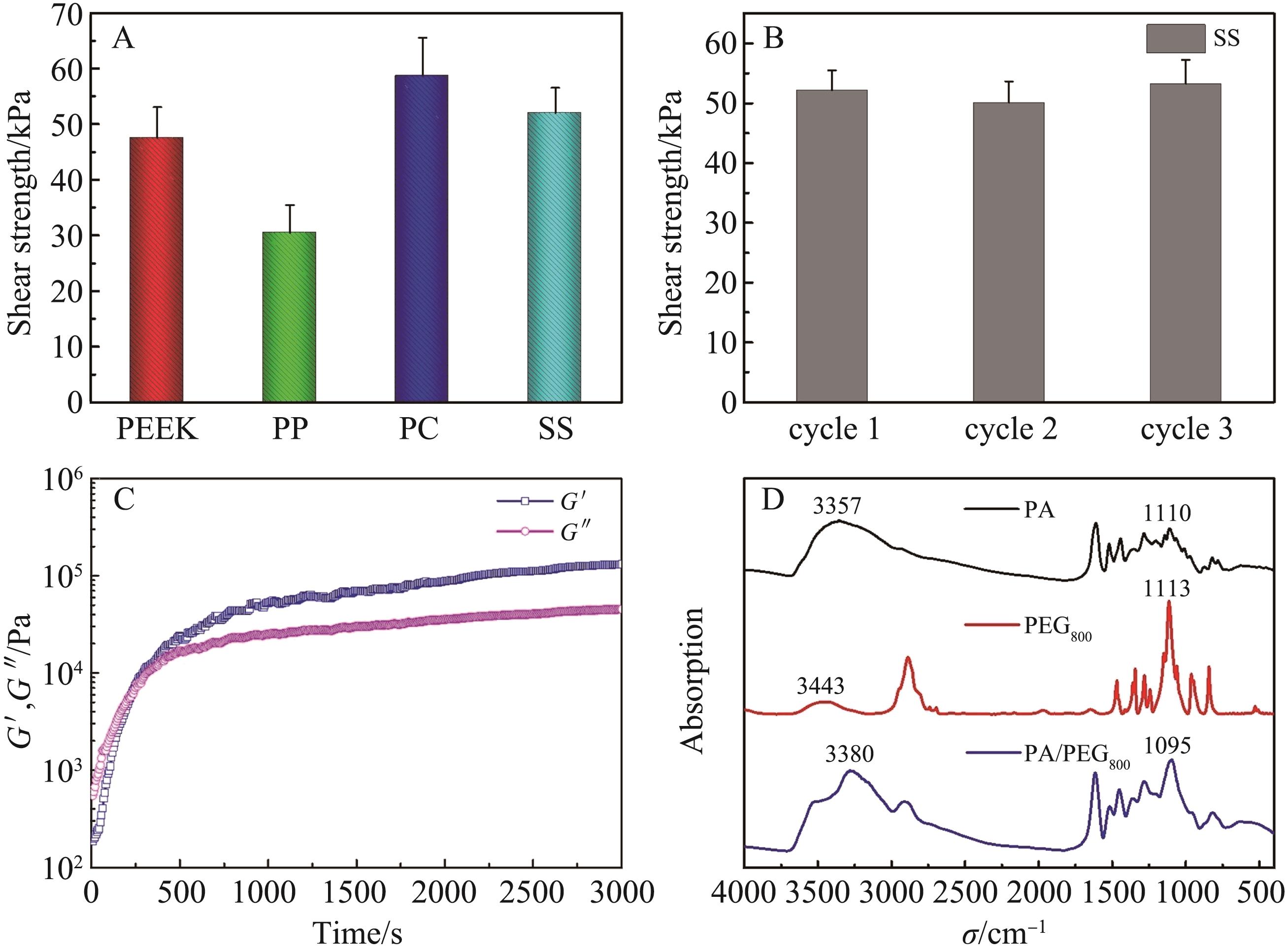
Fig.5 (A) Underwater shear adhesion strengths of the PA/PEG800 adhesive bonded to different substrates (PEEK, PP, PC, SS); (B) underwater shear strengths of PA/PEG800 adhesive along with the attachment/detachment cycles (obtained from SS substrates); (C) dynamic rheology behavior over time after the adhesive was broken by applying a 200% strain amplitude sweep; (D) FT-IR spectra of PA, PEG800 and PA/PEG800 complex in the range of 4000 ~ 400 cm-1

Fig.6 (A) 1H NMR spectra of PA, PEG800 and PA/PEG800 adhesive; (B) underwater shear strengths of PA/PEG1000, PA/MPEG1000 and PA/MdPEG1000 adhesive (obtained from SS substrates); (C) digital images of complex formed from the co-assembly of PA and PVA; (D) the bacterial colonies calculated by a colony count method after the E.coli cells are treated with PA, PEG800 and PA/PEG800
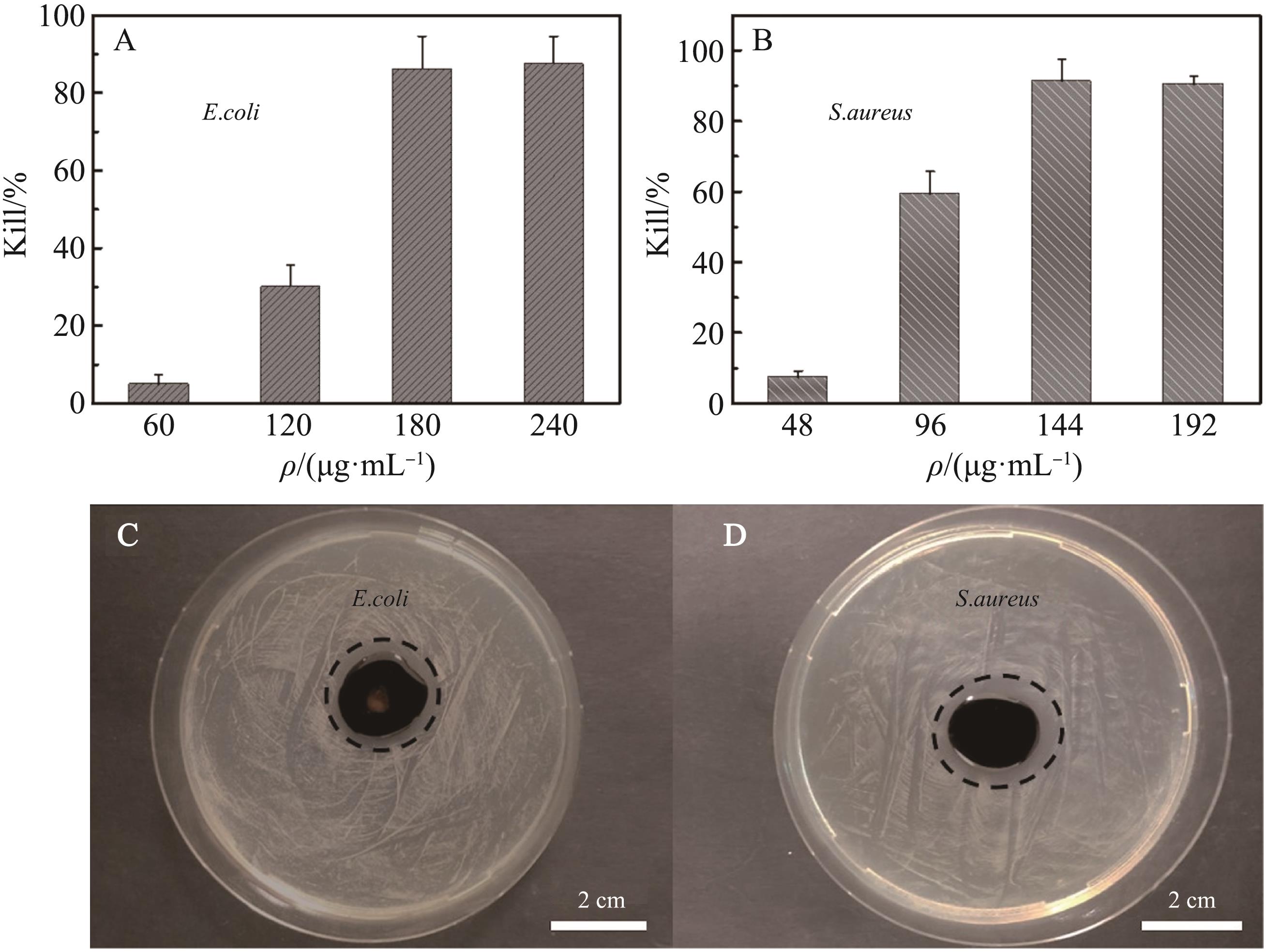
Fig.7 The kill ratio of PA/PEG800 with different concentration for (A) E.coli and (B) S.aureus cells, the inhibitory effect of PA/PEG800 adhesive for (C) E.coli and (D) S.aureus cells on agar plates
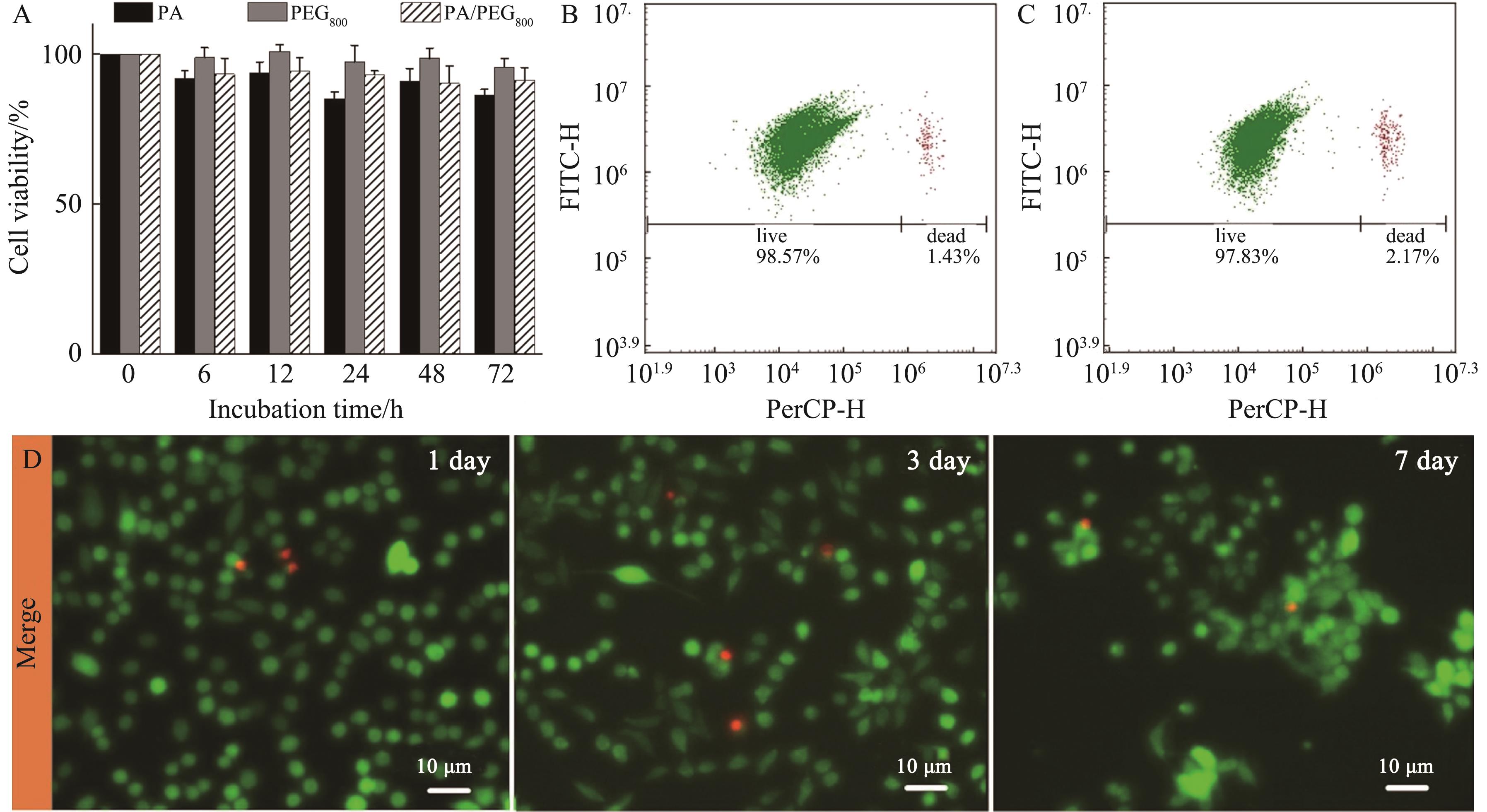
Fig.9 (A) Histogram of cell survival rates of PA, PEG800, PA/PEG800 on L-929 cells; flow cytometry of the effects of (B) the blank and (C) PA/PEG800 samples on L-929 cells; (D) LSCM images of L-929 cells with PA/PEG800 following different incubation times
| 1 | ALEKSHUNl M N, LEVY S B. Molecular mechanisms of antibacterial multidrug resistance[J]. Cell, 2007, 128(6):1037-1050. |
| 2 | TAUBES G. The bacteria fight back[J]. Science, 2008, 321(5887): 356-361. |
| 3 | BAYM M, STONE L, KISHONY R. Multidrug evolutionary strategies to reverse antibiotic resistance[J]. Science, 2016, 351(6268): aad3292. |
| 4 | HE W, WANG Z, HOU C, et al. Mucus-inspired supramolecular adhesives with oil-regulated molecular configurations and long-lasting antibacterial properties[J]. ACS Appl Mater Interfaces, 2020, 12(14): 16877-16886. |
| 5 | ALFONSO A, NICOLÁS G, MARÍA P, et al. Synthesis and evaluation of antimicrobial and antibiofilm properties of a-type procyanidin analogues against resistant bacteria in food[J]. J Agr Food Chem, 2018, 66 (9): 2151-2158. |
| 6 | LI J, CHEN Z J, ZHOU M C, et al. Polyoxometalate-driven self-assembly of short peptides into multivalent nanofibers with enhanced antibacterial activity[J]. Angew Chem Int Ed, 2016, 55(7): 2592-2595. |
| 7 | XIE X, GAO B, MA Z, et al. Host-guest interaction driven peptide assembly into photo-responsive 2D nanosheet with switchable antibacterial activity[J]. CCS Chem, 2020, 2(7): 1949-1962. |
| 8 | WAN Y, LIU L, YUAN S, et al. pH-responsive peptide supramolecular hydrogels with antibacterial activity[J]. Langmuir, 2017, 33(13): 3234-3240. |
| 9 | LI X, ZHENG T, LIU X, et al. Coassembly of short peptide and polyoxometalate into complex coacervate adapted for pH and metal ion-triggered underwater adhesion[J]. Langmuir, 2019, 35(14): 4995-5003. |
| 10 | KIM K, SHIN M, KOH M, et al. TAPE: a medical adhesive inspired by a ubiquitous compound in plants[J]. Adv Funct Mater, 2015, 25(16): 2402-2410. |
| 11 | CHEN C, GENG X, PAN Y, et al. Synthesis and characterization of tannic acid-PEG hydrogel via Mitsunobu polymerization[J]. RSC Adv, 2020, 10(3): 1724-1732. |
| 12 | KITADAI N, YOKOYAMA T, NAKASHIMA S. ATR-IR spectroscopic study of L-lysine adsorption on amorphous silica[J]. J Colloid Interf Sci, 2009, 329(1): 31-37. |
| 13 | GUO J, SUN W, KIM J, et al. Development of tannin-inspired antimicrobial bioadhesives[J]. Acta Biomater, 2018, 72: 35-44. |
| 14 | CHEN C, YANG X, LI S. Tannic acid-thioctic acid hydrogel: a novel injectable supramolecular adhesive gel for wound healing[J]. Green Chem, 2021, 23(4): 1794-1804. |
| 15 | MA C, PANG H, SHEN Y, et al. Plant polyphenol-inspired crosslinking strategy toward high bonding strength and mildew resistance for soy protein adhesives[J]. Macromol Mater Eng, 2021, 306(12): 2100543. |
| 16 | 郭少波, 梁艳莉, 刘智峰, 等. 四环素-Ag复合材料的协同抑菌性能[J]. 应用化学, 2021, 11(38): 1462-1468. |
| GUO S B, LIANG Y L, LIU Z F, et al. Synergistic antibacterial activity of tetracycline combined with silver nanoparticles[J]. Chinese J Appl Chem, 2021, 11(38): 1462-1468. | |
| 17 | 暴金平, 樊素芳, 杨国玉, 等. 壳寡糖氨基硫脲席夫碱铜的制备及其抗真菌活性[J]. 应用化学, 2019, 36(5): 500-508. |
| BAO J P, FAN S F, YANG G Y, et al. Synthesis and antifungal activities of chitosan oligosaccharide thiosemicarbazone schiff base Cu(Ⅱ) complex[J]. Chinese J Appl Chem, 2019, 36(5): 500-508. | |
| 18 | CHANG R, SUBRAMANIAN K, WANG M, et al. Enhanced antibacterial properties of self-assembling peptide amphiphiles functionalized with heparin-binding cardin-motifs[J]. ACS Appl Mater Interfaces, 2017, 9(27): 22350-22360. |
| 19 | 刘娇, 邹鹏飞, 李平, 等. 多肽类自组装纳米材料对抗细菌耐药的研究进展[J]. 应用化学, 2021, 38(5): 546-558. |
| LIU J, ZOU P F, LI P, et al. Research progress of the peptide-based self-assembled nanomaterials against microbial resistance[J]. Chinese J Appl Chem, 2021, 38(5): 546-558. |
| [1] | Jia-Cheng ZHOU, Dong-Dong WANG, Yun-Bao GAO, Jing JIN, Wei JIANG. Rheological Properties and Bonding Properties of Modified Poly(Propylene Carbonate) Pressure-sensitive Adhesive [J]. Chinese Journal of Applied Chemistry, 2023, 40(6): 871-878. |
| [2] | Bi-Ru SHI, Hao-Hao WU, Hao-Pu XIE, Xin-Xin TIAN, Ying-Lu SUN, Xiang-Dong LIU, Yu-Ming YANG. Preparation and Properties of Self-healing Polyurethane Adhesives with Diels-Alder Bonds [J]. Chinese Journal of Applied Chemistry, 2023, 40(2): 277-287. |
| [3] | Wei-Qiang ZHANG, Chen WANG, Yu-Rong ZHAO, Dong WANG, Ji-Qian WANG, Hai XU. Research Progress of Regulation of Driving Forces in Short Peptide Supramolecular Self‑Assembly [J]. Chinese Journal of Applied Chemistry, 2022, 39(8): 1190-1201. |
| [4] | Ren MU, Shun NA, Natsagdorj NARANTSOGT, Chong-Jiu LI. Effect of Dimethyl Sulfoxide on the Retention Time of Acetic Acid in Gas Chromatography and Its Mechanism [J]. Chinese Journal of Applied Chemistry, 2022, 39(5): 852-854. |
| [5] | Dong-Qing CAI, Jing ZHANG, Qing-Chuan WU, Jing-Hong YE, Lin-Ying WANG, Dong-Fang WANG. Preparation and Application of Attapulgite Based Nano⁃controlled Chlorpyrifos [J]. Chinese Journal of Applied Chemistry, 2022, 39(11): 1774-1782. |
| [6] | Feng-Shuo LIU, Qian DONG, Zhong-Fu ZHAO, Wei LIU, Chun-Qing ZHANG. Structure and Performance Modulation of Self‑Adhesive SIS/C5 Electrospun Membranes for Transdermal Drug Delivery [J]. Chinese Journal of Applied Chemistry, 2022, 39(10): 1523-1532. |
| [7] | YANG Jia-Qiang,WU Xue-Jiao, ZHOU Xu-Rong, DENG Ling, YANG Hong. Synthesis and Antibacterial Activities of Osthole Ester Derivatives [J]. Chinese Journal of Applied Chemistry, 2021, 38(8): 917-922. |
| [8] | Meng-Wei LI, Hong-Yan WANG, Ying-Ying WANG, Xiao-Ying KANG, Mei-Fang LIU, Yu-Lan CHEN. Supramolecular Self⁃Assembly of Azobenzene⁃4,4'⁃dicarboxylic Acid Derivatives in Water [J]. Chinese Journal of Applied Chemistry, 2021, 38(10): 1362-1370. |
| [9] | XING Yayan, SHI Yuzhe, DENG Shixian, ZHAO Baihan, LIU Zhiguo. Preparation and Application of Catechin-Silver Nanocomposites [J]. Chinese Journal of Applied Chemistry, 2020, 37(9): 1062-1068. |
| [10] | XU Bing, WU Zhongkui, MIAO Linhui, WANG Zhenkun, DAI Siyu, ZHU Zhe. Properties of Acrylate Pressure Sensitive Adhesive [J]. Chinese Journal of Applied Chemistry, 2020, 37(7): 778-784. |
| [11] | CHENG Yinjie, ZHANG Lu, HU Renjie, WANG Ying, JIN Xuexin, QIU Shuo, ZHANG Haoyan, JIANG Dawei. Preparation and Characterization of Hydrogen-Bonded Carbon Nanotubes Reinforced Self-healing Composites [J]. Chinese Journal of Applied Chemistry, 2020, 37(10): 1147-1155. |
| [12] | YANG Jin,MA Qiseng,ZHONG Ying,ZHU Longbao,GE Fei,TAO Yugui,SONG Ping. Solid-Phase Synthesis of Cyclohexapeptide Thermoactinoamide A and Its Antibacterial Activity [J]. Chinese Journal of Applied Chemistry, 2019, 36(6): 677-682. |
| [13] | WANG Wenxu,HUANG Bingyu,TAN Licheng,HAN Jihui,CHEN Lie,XU Haitao,CHEN Yiwang. Research Progress of Addition Type Liquid Silicone Rubber [J]. Chinese Journal of Applied Chemistry, 2018, 35(9): 1005-1012. |
| [14] | LING Huiping,CHEN Xiaoqing,XIE Shengnan,CHEN Yuejian,SHE Zhigang,LIN Yongcheng,TAO Yiwen. Dihydroisocoumarin Compounds from Endophytic Fungi of Rhizophora apiculata and Its Antibacterial Activity [J]. Chinese Journal of Applied Chemistry, 2018, 35(6): 708-713. |
| [15] | WEN Lijun, WANG Ying, LI Haixia, LI Juan. Synthesis and Antibacterial Activity of 5,6-Dimethyl-2,3-pyrazinedimethylformamide-Cu [J]. Chinese Journal of Applied Chemistry, 2016, 33(9): 1056-1060. |
| Viewed | ||||||
|
Full text |
|
|||||
|
Abstract |
|
|||||
